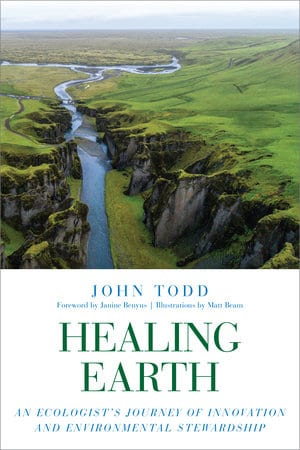Healing Earth – An Ecologist’s Journey of Innovation and Environmental Stewardship
 Written by John Todd
Written by John Todd
Published by North Atlantic Books, 2019
Reviewed by Cindy Goulder
It’s easy to be overwhelmed with despair by the many degradations of our natural world and the tumultuous effects expected of the changing climate. But John Todd is not despairing. His new book, Healing Earth, written as he approaches 80 years old, is full of hope and optimism from the very first chapter and can be a source of hope for us all.
John Todd is known as a pioneer in the field of ecological design, starting in the 1980s with his “eco-machines,” analogs of marsh, pond, and stream ecosystems strung together in a series of translucent tanks to clear wastewaters of contaminants and remediate degraded water bodies. These have been put to use in various forms around the planet and have inspired further water-cleansing technologies.
Todd is not as much about conserving or restoring biodiversity as about using it to create healthy ecosystems. His approach is to bring together subsets of different ecosystems, gathering a great diversity of organisms that he says must include representative species from all six kingdoms of life (recalling that four of these are microbial) in order to function properly. He’s n His “eco-machines,” for example, assemble thousands of species, compelling them to sort and organize themselves into systems uniquely adapted to their circumstances, in this way accomplishing the intended purposes.
Todd has created aquaculture systems for growing fish, vegetables, greens, and herbs all at once, and, with marine engineers, has developed carbon-neutral wind- and solar-powered vessels for delivering materials and supplies for ecological engineering projects for shoreline restoration, island agriculture and aquaculture, and water management projects in coastal regions. Among his terrestrial projects is one catalyzing healthy soil formation, successional revegetation, water circulation, and eventual farming on a strip-mine site in South Africa. Beyond his task-specific eco-technologies, he envisions more complex symbiotic systems, such as agro-industrial parks in urban areas and, most broadly, whole systems with economic and social as well as biological components in a bioregional, carbon neutral, and successional framework.
Healing Earth presents us with these and others of Todd’s diverse projects. The book is a manual of healing techniques, easily readable despite its complex subject matter, with clear illustrations and diagrams, and a descriptive list of design and operating principles developed with others over the years. For each project, it elucidates the principles, patterns, and processes Todd sees at work in them, and invites and inspires us to take them further.
The intrinsic capability of natural systems to heal themselves is the source of Todd’s sense of hope, borne out to him time and again through his keen scrutiny of ecological systems around the planet, particularly their self-regulating qualities, starting with the seagrass meadows near his home. His thinking is grounded in the Gaia theory of his mentors Drs. Lynn Margulis and James Lovelock, who see earth as a living, constantly evolving cybernetic system that self-designs, self-organizes, self-regulates, and self-repairs on all scales.
Todd’s intention is to carry out Dr. H.T. Odum’s 1972 prediction that an ecological design science can “provide the basis for a technological revolution suited to an age of resource limitations and a degraded planet.” He says we have to think of ourselves as “nature’s junior partner,” with stewardship as our ecological niche. Our first task is to scrutinize natural systems, discover their operating instructions, and design analogs that will accomplish the healing objectives we seek.
This is, however, only the beginning. Acknowledging that dependency on exploitive, energy intensive, heavily engineered and wasteful petroleum-based technologies has led to the environmental degradation we now face, he calls on us to shift away from it and instead to meet human needs by fully allying ourselves with the diversity and bounty of life and the recuperative powers of nature. The growing number of us now training in ecological thinking and techniques, and the rise of more and more eco-centric technologies, projects, and economies producing food, fresh water, and ecological stability around the planet are what give him hope for the future.
About the Reviewer
Cindy Goulder is a Brooklyn, NY landscape designer and garden maker bringing together experience in artful garden design, ecological restoration, and permaculture. Through her business Ecological Landscapes / Urban Gardens, she serves homeowners, community gardening groups, and others with challenged sites and gardening hopes. She also gives workshops in ecology based garden-making techniques. Cindy is an ELA Board member.
***
Each author appearing herein retains original copyright. Right to reproduce or disseminate all material herein, including to Columbia University Library’s CAUSEWAY Project, is otherwise reserved by ELA. Please contact ELA for permission to reprint.
Mention of products is not intended to constitute endorsement. Opinions expressed in this newsletter article do not necessarily represent those of ELA’s directors, staff, or members.

